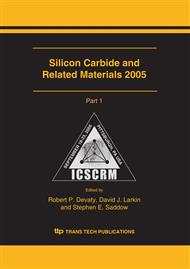p.843
p.847
p.851
p.855
p.859
p.863
p.867
p.871
p.875
An Approach to Improving the Morphology and Reliability of n-SiC Ohmic Contacts to SiC Using Second-Metal Contacts
Abstract:
While nickel ohmic contacts to n-type silicon carbide have good electrical properties, the physical contact, and therefore the reliability, can be poor. An approach is described for using the good electrical properties of Ni ohmic contacts while using another metal for its desired mechanical, thermal and/or chemical properties. In the present work, once the Ni contacts have been annealed forming nickel silicides and achieving low contact resistance, they are etched off. Removing the primary Ni contacts also eliminates the poor morphology, voids, and at least some of the excess carbon produced by the Ni/SiC reaction. The Ni contacts are then replaced by a second contact metal. This second metal displays low contact resistance as-deposited, indicating that the critical feature responsible for the ohmic contact has not been removed by the primary contact etch. Not only does this approach provide more flexibility for optimizing the contact for a given application, it also provides some insight into the ohmic contact formation mechanism.
Info:
Periodical:
Pages:
859-862
Citation:
Online since:
October 2006
Authors:
Price:
Сopyright:
© 2006 Trans Tech Publications Ltd. All Rights Reserved
Share:
Citation:


